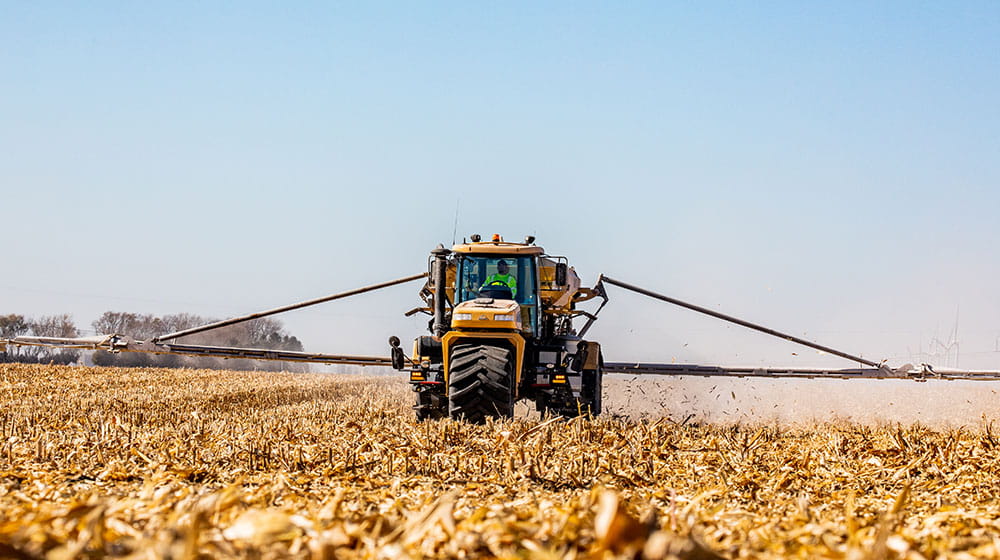As the growing season winds down, many producers shift their focus to harvest logistics and winter preparations. But fall is also a critical window for fertility planning, one that can significantly influence next season’s yield potential. By understanding the science behind nutrient uptake and soil health, growers can make informed decisions that set the stage for a productive spring.
Why fall fertility planning matters
Fall fertility planning isn’t just about checking a box before winter. It’s a strategic move that leverages seasonal soil conditions to optimize nutrient availability and uptake. Cooler temperatures, reduced microbial activity, and lower crop competition create ideal conditions for soil amendments to integrate and stabilize. This timing allows nutrients to be more readily available when crops need them most in the spring.
Nutrient uptake: Timing is everything
Plants require a balanced supply of nutrients throughout their growth cycle, but early-season access is especially critical. Nutrients like phosphorus and potassium play key roles in root development, energy transfer, and overall plant vigor. Applying these nutrients in the fall gives them time to bind with soil particles and become plant-available by spring.
Additionally, fall applications can help mitigate nutrient loss. For example, nitrogen applied in the spring is more susceptible to leaching and volatilization due to warmer temperatures and rainfall. By using stabilized nitrogen sources or incorporating cover crops in the fall, growers can reduce these risks and improve nitrogen use efficiency.
Soil health benefits of fall fertility
Healthy soil is the foundation of successful crop production. Fall fertility planning supports soil health in several ways:
1. Improved organic matter integration
Incorporating organic amendments like compost or manure in the fall allows them to break down over winter, enriching the soil with organic matter. This improves soil structure, water retention and microbial activity, all essential for nutrient cycling and root development.
2. Enhanced microbial activity
While microbial activity slows in colder months, fall applications give microbes a head start. Nutrients and organic matter added in the fall stimulate microbial populations, which play a vital role in decomposing residues and converting nutrients into plant-available forms.
3. Balanced pH and cation exchange capacity
Fall is an ideal time to address soil pH issues with lime applications. Adjusting pH improves nutrient availability and enhances cation exchange capacity (CEC), allowing soil to hold and release nutrients more effectively.
Strategic planning for long-term gains
Fall fertility planning isn’t just about immediate results, it’s about building a resilient system that supports long-term productivity. By conducting soil tests in the fall, growers can identify nutrient deficiencies and tailor their fertility programs accordingly. This proactive approach reduces guesswork, minimizes input costs and supports environmental stewardship.
Tips for effective fall fertility planning:
- Conduct soil tests to determine nutrient levels and pH.
- Apply phosphorus and potassium based on crop removal rates and soil test recommendations.
- Consider stabilized nitrogen sources or cover crops to reduce nitrogen loss.
- Incorporate organic amendments to boost soil organic matter.
- Adjust pH with lime if needed, allowing time for it to react before spring planting.
One of the most effective tools for fall fertility planning is Trivar® EZ, a granular micronutrient blend from CHS designed to enhance nutrient efficiency and availability. Powered by Levesol®, the most agronomically proven chelate on the market, Trivar EZ prevents micronutrients from binding with phosphorus, keeping more nutrients free and accessible for plant uptake
- Enhanced nutrient uptake: Trivar EZ increases the availability of phosphorus and essential micronutrients like calcium, manganese, molybdenum, sulfur, and zinc.
- Chelation technology: The patented Levesol chelate works both in the soil and on the fertilizer, preventing nutrient tie-up and improving overall nutrient efficiency.
- Flexible application: Trivar EZ is a dry, easy-to-mix granular blend that integrates seamlessly with dry fertilizer, ideal when impregnation isn’t an option.
- Uniform distribution: Micronutrients are evenly distributed in fertilizer mixes, ensuring consistent nutrition across the field.
- Crop versatility: Suitable for a wide range of crops including corn, soybeans, potatoes, sugarbeets, cotton, canola and small grains
By incorporating Trivar EZ into fall fertility programs, growers can give their crops a head start in the spring leading to healthier plants, stronger root systems and improved yield potential.
Fall fertility planning is a powerful tool for maximizing yield potential and promoting soil health. By aligning nutrient applications with seasonal soil dynamics and leveraging advanced solutions like Trivar EZ, growers can ensure their crops have the resources they need to thrive from day one.
To learn more about how Trivar EZ can support your fall fertility strategy, contact your local CHS agronomy expert.




